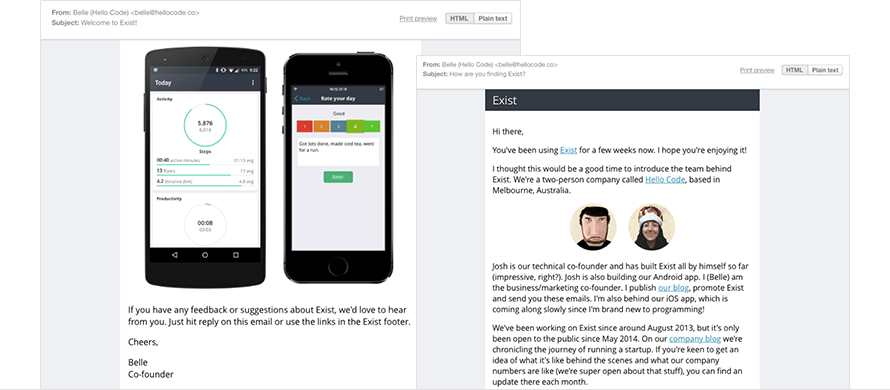A free trial gives prospective customers the opportunity to try your product in the context of their own data, their own business, their environment, and the way they work.
Free trials also give you a bullseye to focus on: getting users to see the value in your product before the trial ends.
This means making sure they actually try the product, making sure they understand it, and helping them test it fully in the context of their own needs.
How users think about free trials
If you don’t understand how customers think about your product and the process of a free trial, you’ll have a much harder time convincing them to convert to a paid account.
Initial behavior
A study published in the Journal of Marketing Research found that free trial customers behaved differently than customers who paid for a product right when they signed up. The authors said starting a relationship through a free trial, “influences usage and retention behavior, responsiveness to marketing activities, and ultimately how long the consumer will remain with the service.”
The study focused on a digital TV provider, so the results shouldn’t be applied haphazardly to SaaS. Two of the findings, however, paint a pretty interesting picture:
Customers who had free trials valued the service less, so they were actually less likely to remain customers on average. However, they were far more open to marketing messages.
For customers on a free trial, the more they used the service, the more likely they were to remain customers. This is something we commonly see in SaaS:
If users aren’t using your product during the trial, what do you think their response will be when you ask them to pay?
Take action: When crafting marketing messages for free trial users, be mindful of the inertia you’re overcoming: they have to understand how to use the product, and they have to see the value in investing their time. Be laser focused on highlighting the main benefits of your product and the features closely associated with long-term success.
Personalized communication
It’s quite helpful to personalize your communication during a free trial. Getting to know your customers is easier if you give them the chance to get to know you.
For our Exist campaign, all of the emails come directly from me, so new users have a direct line to one of the founders from the start. Every email is sent from my personal address, so users can reply and start a conversation with me at any time. By the end of their trial they know the name and face of a real person at the company.

Take action: Add some personality to your communications with free trial users. Let them know you care, and make them feel supported by making it easy for them to reach out for help or to ask questions. This is a critical time, so you want to leave an impression that shows how you treat your customers, and how great your support is.
Watch what I do, not what I say
Understanding how your customers think about your product is one thing, but knowing what they do and why can be even more useful.
When the team behind blogging platform Ghost were trying to improve their free trial conversions, they took careful note of the steps each customer took to set up his or her account and looked at which ones correlated most closely with converting to a free account.
At first, founder John O'Nolan assumed publishing a post would be the “Aha! moment” that would lead to more trial customers converting. John was surprised to find that the biggest difference actually came from a different step: installing a custom theme. Compared to users who didn’t add a custom theme, these customers converted 10x more often.
Out of the three user actions that made the most impact on whether a user converted after the trial—adding a custom theme, adding a custom domain, and publishing a post—publishing a post was actually least effective.
Without exploring the data directly, John’s understanding of his users would have had big gaps in it and he would have missed the opportunity to encourage more free trial users to add custom themes, thus decreasing their likelihood of converting.
Take action: Pay attention to the actions your users take within your product. This is the best measure of what they want to get out of it and why they find it useful (or not).
What you don’t know can hurt you
The team at Trak.io found their free trial customers fell into several different categories, depending on their use of and need for the product:
Not interested at all. They churn within the first few minutes without even integrating a tracking code. They never come back.
Not interested in integrating a tracking code right now, but they might come back to test when they have an appropriate project.
They tested the product, but they hated it. There’s too much wrong, and they’ll never come back to try it again.
They tested the product, and they loved it! But they just don’t need it right now.
They tested the product, they loved it, and they paid without problem at the end of the free trial.
They tested the product, and they liked it. They do have a need right now, but there’s at least one problem stopping them from subscribing.
Focusing on group #6, the team found these were the lowest hanging fruit among all free trial users. But using automated exit interview emails at the end of each free trial wasn’t giving them the answers they needed. Without knowing what was holding these users back from converting, the Trak.io team was lost when it came to taking action.
The solution they came up with was adding a free trial extension option. On the payment screen they added a self-serve option to extend a user’s free trial by 3 days so long as they fill in a text field explaining why they’re not yet ready to pay:

One of the big questions that arose when implementing this option was whether people would abuse the option to extend their trial instead of paying. Setting the extension at just three days made it inconvenient for users to take advantage of it over and over, but it still gave the team a long enough period to help customers who needed support or add longer trial extensions manually if needed.
Take action: Try offering customers an option to extend their free trial when it’s time to pay. If they’re on the fence about purchasing, this lets them try it for longer to get a better feel for it. For collaborative software, new users might need extra time to get all of their team on board for testing the product in context.
Keep in mind, though, that users asking for free trial extensions may be a symptom of an underlying problem. Lincoln Murphy suggests free trial extension requests may point to issues like free trials that aren’t set up to convert, customers who aren’t finding quick wins during their trial, or even that you’re attracting the wrong customers in the first place.
Another learning point that came from Trak.io’s experience was how many customers had signed up for a free trial but not evaluated the product at all when their 30-day trial was up. Because they didn’t get a nudge to pay until 30 days later, a lot of users had forgotten to try the product and weren’t ready to pay.
Shortening the trial period to 14 days encouraged users to make sure they tested the product before their time was up, and it condensed the period between signing up and the nudge to pay for their account.
Take action: Longer trial periods aren’t necessarily better. When looking at your conversion rate data, consider how your trial length is affecting those numbers.
Bottom line, there’s no “one size fits all” answer to improving trial conversion rates. Every product is different.
But the more you get to know your customers, the better you’ll understand what success looks like to them, and what options will help them get there. That’s the smart path to improving conversion.



